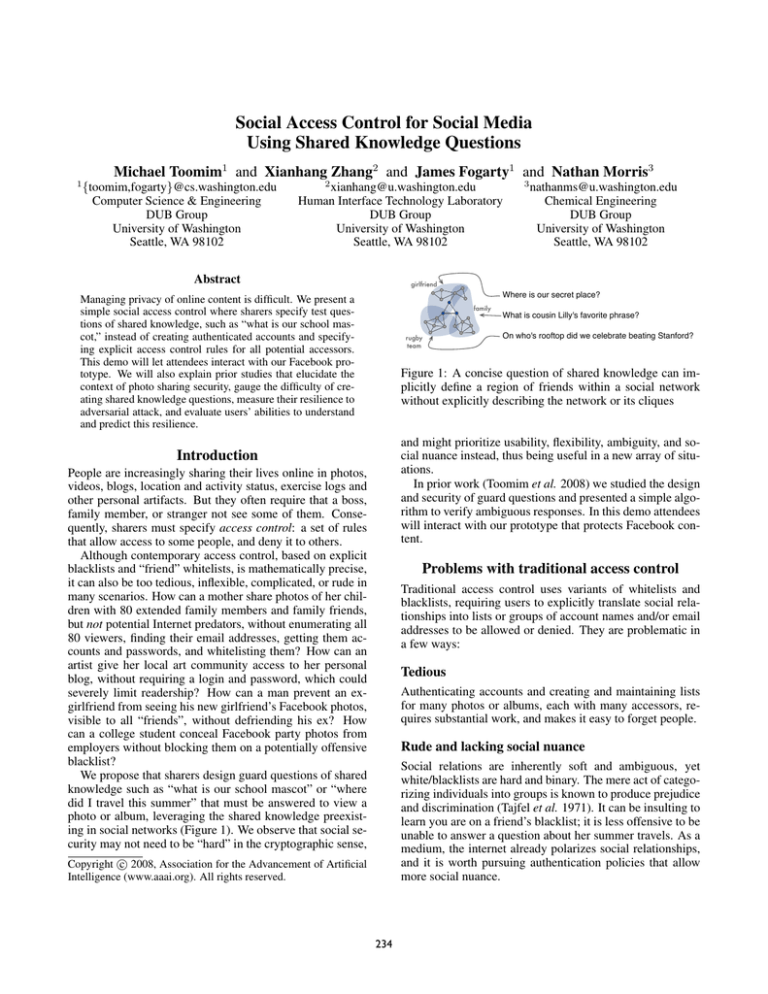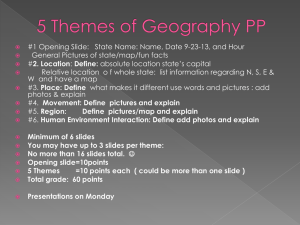
Social Access Control for Social Media
Using Shared Knowledge Questions
Michael Toomim1 and Xianhang Zhang2 and James Fogarty1 and Nathan Morris3
1
{toomim,fogarty}@cs.washington.edu
Computer Science & Engineering
DUB Group
University of Washington
Seattle, WA 98102
2
xianhang@u.washington.edu
Human Interface Technology Laboratory
DUB Group
University of Washington
Seattle, WA 98102
Abstract
3
nathanms@u.washington.edu
Chemical Engineering
DUB Group
University of Washington
Seattle, WA 98102
girlfriend
Where is our secret place?
Managing privacy of online content is difficult. We present a
simple social access control where sharers specify test questions of shared knowledge, such as “what is our school mascot,” instead of creating authenticated accounts and specifying explicit access control rules for all potential accessors.
This demo will let attendees interact with our Facebook prototype. We will also explain prior studies that elucidate the
context of photo sharing security, gauge the difficulty of creating shared knowledge questions, measure their resilience to
adversarial attack, and evaluate users’ abilities to understand
and predict this resilience.
family
rugby
team
What is cousin Lilly's favorite phrase?
On who's rooftop did we celebrate beating Stanford?
Figure 1: A concise question of shared knowledge can implicitly define a region of friends within a social network
without explicitly describing the network or its cliques
and might prioritize usability, flexibility, ambiguity, and social nuance instead, thus being useful in a new array of situations.
In prior work (Toomim et al. 2008) we studied the design
and security of guard questions and presented a simple algorithm to verify ambiguous responses. In this demo attendees
will interact with our prototype that protects Facebook content.
Introduction
People are increasingly sharing their lives online in photos,
videos, blogs, location and activity status, exercise logs and
other personal artifacts. But they often require that a boss,
family member, or stranger not see some of them. Consequently, sharers must specify access control: a set of rules
that allow access to some people, and deny it to others.
Although contemporary access control, based on explicit
blacklists and “friend” whitelists, is mathematically precise,
it can also be too tedious, inflexible, complicated, or rude in
many scenarios. How can a mother share photos of her children with 80 extended family members and family friends,
but not potential Internet predators, without enumerating all
80 viewers, finding their email addresses, getting them accounts and passwords, and whitelisting them? How can an
artist give her local art community access to her personal
blog, without requiring a login and password, which could
severely limit readership? How can a man prevent an exgirlfriend from seeing his new girlfriend’s Facebook photos,
visible to all “friends”, without defriending his ex? How
can a college student conceal Facebook party photos from
employers without blocking them on a potentially offensive
blacklist?
We propose that sharers design guard questions of shared
knowledge such as “what is our school mascot” or “where
did I travel this summer” that must be answered to view a
photo or album, leveraging the shared knowledge preexisting in social networks (Figure 1). We observe that social security may not need to be “hard” in the cryptographic sense,
Problems with traditional access control
Traditional access control uses variants of whitelists and
blacklists, requiring users to explicitly translate social relationships into lists or groups of account names and/or email
addresses to be allowed or denied. They are problematic in
a few ways:
Tedious
Authenticating accounts and creating and maintaining lists
for many photos or albums, each with many accessors, requires substantial work, and makes it easy to forget people.
Rude and lacking social nuance
Social relations are inherently soft and ambiguous, yet
white/blacklists are hard and binary. The mere act of categorizing individuals into groups is known to produce prejudice
and discrimination (Tajfel et al. 1971). It can be insulting to
learn you are on a friend’s blacklist; it is less offensive to be
unable to answer a question about her summer travels. As a
medium, the internet already polarizes social relationships,
and it is worth pursuing authentication policies that allow
more social nuance.
c 2008, Association for the Advancement of Artificial
Copyright Intelligence (www.aaai.org). All rights reserved.
234
Category of person or
group of people
Friends
Family
Strangers
Specific people by name
Common interest group
Friends of photographed
Authority figures
Ex-friends and romances
Potential romances and
employers
Desired
Freq.
90%
76%
0%
46%
38%
34%
21%
0%
10%
Imp.
2.2
2.4
-2.8
1.7
2.5
3.2
-3.5
Undesired
Freq Imp.
41% 3.0
79% 3.0
72% 2.8
24% 2.4
41% 3.0
0%
-42% 3.0
14% 2.7
7%
3.6
Question Type
About themselves
Knowledge of a
mutual friend
About a specific
place or event
About the guesser
Inside joke or
reference
General Knowledge
Figure 2: Desired and undesired people to see photos, as
described by participants. Freq is percentage of responses
that include a category. Imp is mean rated importance of the
responses in a category, on our 1-4 ordinal scale.
Example Question
What's my favorite spirit
for mixed drinks?
What was the name of
Susan's hairy dog?
In what country did I
work in Europe?
What river did we float
down for Keith's B-Day?
Spiky red hair on the
dance floor drink
The "AP" in AP Stats
stands for?
Freq.
48%
13%
12%
10%
8%
6%
Figure 3: Categories of participant-designed questions
abilities to predict this resilience. This section summarizes
our results from (Toomim et al. 2008).
We first collected data on the groups of people with whom
people want to share and not share photos, and how important they are. 31 participants found 179 personal photos and
reported who they wanted to and not to see each photo. We
clustered the responses in Figure 2. Demonstrating a need
for flexible access control, 83% of participants had photos to
blacklist from “family” or “friends”, which are commonly
assumed to be whitelist groups in sharing websites.
We then had participants design questions to protect each
of these photos. We clustered their responses in Figure 3.
Participants were able to find questions that implement their
inclusion/exclusion preferences for 98% of the photos, indicating shared knowledge exists to represent most privacy
situations. It took a mean of 15 seconds to design a question, with standard deviation of 28. For comparison, it takes
the first author 90 seconds to create a 10-person whitelist of
email addresses using the Mac OSX Address Book.
Finally, we uploaded the questions as jobs to Amazon’s
Mechanical Turk, and rewarded anonymous Internet users
to guess the answers. Guessers had a 6% chance of cracking
a question in 3 guesses, and only 7 of the 168 questions (4%)
were more than 30% easier to crack than sharers estimated.
Inexpressive or complicated
To alleviate the tedium of large lists, websites let users white
or blacklist predefined groups of users, such as “friends and
family”. However, these do not allow personalized groups,
such as “close friends”, or special exclusions like an exboyfriend.
On the other hand, more expressive grouping mechanisms, such as UNIX groups, become, become complicated
to use in ways similar to programming: they require education, abstract reasoning, advance planning, and debugging. Thus, white and blacklists exist in a bounded sea of
zero-sum tradeoffs: without groups they are tedious, with
arbitrary groups they are complicated, and with predefined
groups they are inexpressive. Guard questions may be more
flexible.
Preventing guesses from unintended users
It is reasonable to expect some motivated users to guess
answers to questions. They might covertly persuade the
sharer’s friends to reveal hints, or brute-force guess a question with a finite set of choices such as “what color is my
car?” Our application mitigates such attempts with two
mechanisms. First, hard guess limits hinder brute-force attacks. Second, access logs record and display the guessers to
the sharer, creating social repercussions e.g. for friends that
convince relations to leak an answer they were not supposed
to know. The access log also displays friends that forget answers, so the sharer can whitelist them. Although we do not
require authenticated accounts, the implementation of these
features requires some knowledge of the guesser’s identity,
and we discuss tradeoffs amongst three levels of identification in (Toomim et al. 2008).
Conclusions
Questions of shared knowledge are a lightweight alternative
to traditional access control. Their security is enforced socially as well as technically. Our demonstration of this system in a real Facebook application will give attendees a feel
for what it is like to be a sharer or accesser in this model.
References
Tajfel, H.; Billig, M. G.; Bundy, R. P.; and Flament, C.
1971. Social Categorization and Intergroup Behaviour. European Journal of Social Psychology 1(2):149–177.
Toomim, M.; Zhang, X.; Fogarty, J.; and Landay, J. A.
2008. Access Control by Testing for Shared Knowledge. In
CHI ’08: Proceedings of the SIGCHI Conference on Human Factors in Computing Systems, to appear.
Study
We ran a study to learn to whom users want to grant or
deny access, the types of questions they use to divide these
groups, the basic resilience of the questions to attack from
adversaries without access to social knowledge, and user’s
235





